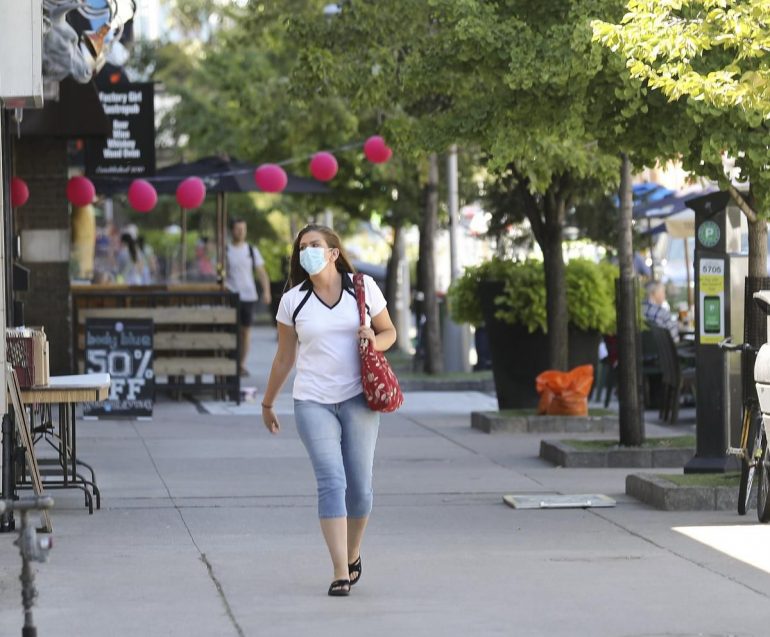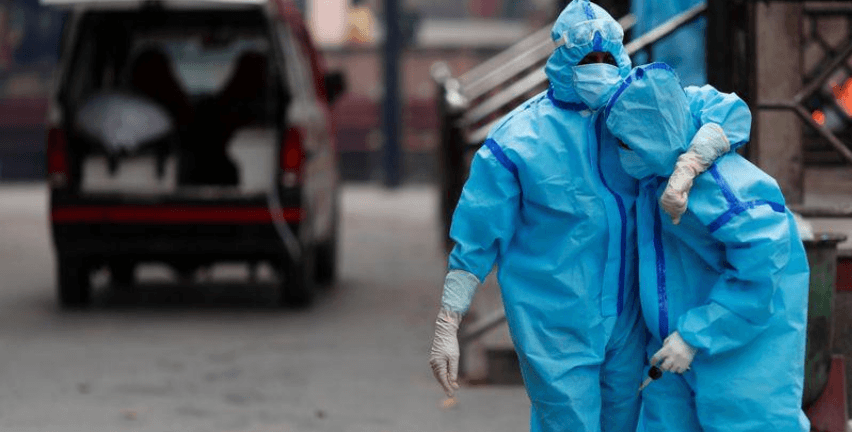The latest coronavirus news from Canada and around the world Wednesday. This file will be updated throughout the day. Web links to longer stories if available.
10:15 a.m.: The number of confirmed coronavirus cases in the Philippines surged past 200,000 Wednesday. The country has the highest number of infections in Southeast Asia.
The Department of Health reported a daily tally of 5,277 recent infections, the majority in Manila. That brings the country’s confirmed total to 202,361 and 3,137 deaths.
President Rodrigo Duterte has faced growing criticisms over the alarming spread of infections. Vice-President Leni Robredo said in televised remarks on Monday: “It’s as if no one is at the helm, no direction, no clear horizon as to when and how this pandemic will be addressed.”
Duterte said Robredo didn’t back up her allegations of government shortcomings with evidence, and her criticisms came amid public desperation. He said, “Please do not add fuel to the fire. You will just destroy the government.”
9:45 a.m.: A campus coalition at Canada’s largest university is urging the school to listen to its own expert research on COVID-19 and roll back its plan to reopen doors to students and staff in the fall.
In an online panel held earlier this week, the University of Toronto Faculty Association discussed what it described as the administration’s refusal to address health and safety concerns raised by staff and students despite the school’s high-profile health-care advocacy work during the global pandemic.
8:50 a.m.: Germany will end mandatory coronavirus tests for travellers returning from high-risk areas abroad and again focus its testing strategy on people with symptoms or possible exposure to COVID-19 patients, the country’s health minister said Wednesday.
Health Minister Jens Spahn said that over the summer vacation period the number of virus tests performed in Germany nearly doubled to 900,000 per week, in part to identify people who caught the virus during trips abroad.
People coming home from coronavirus risk areas were offered free tests at airports, train stations and highway stops, allowing them to cut short the required two-week quarantine if their result came back negative.
Travellers returning from high-risk areas, which include most countries outside the European Union and some regions inside the bloc, will in the future be required to go into mandatory quarantines for at least five days before taking a test, which may no longer be free unless ordered by a doctor.
8:28 a.m.: Egypt’s prime minister is warning about an increase in confirmed cases of coronavirus in the Arab world’s most populous country.
Mustafa Madbouly says his government will keep tightening its preventive measures “to avoid a new wave of the pandemic,” according to the state-run MENA news agency.
Health Minister Hala Zayed is concerned people aren’t wearing face masks or observing social distancing. She called for police to activate penalties for those not wearing masks on public transportation.
The government in July allowed the reopening of mosques, cafes and restraints, and lifted the nighttime curfew. It also reopened selected tourist destinations to international charter flights.
Egypt reported more than 97,600 infections and nearly 5,300 confirmed deaths. However, the actual numbers of infections and deaths from coronavirus, like elsewhere in the world, are likely far higher due to limited testing and reporting.
8:21 a.m.: The city of Urumqi in China’s northwest resumed large-scale virus testing of residents Wednesday to stop a coronavirus outbreak, the government announced.
The Xinjiang region has recorded 826 confirmed virus cases from mid-July through Tuesday in the outbreak, the government reported. It says 124 still were hospitalized.
The announcement says testing would cover “key communities” but gave no indication how many people would be involved.
7:45 a.m.: France’s prime minister is urging his compatriots to wear masks more but insisted Wednesday that rising coronavirus infections across the country are “nothing to panic about” and that it’s time for people to get back to work and school and to “cultivating themselves.”
France is now reporting more than 25 positive virus tests per 100,000 people, up from five per 100,000 a month ago. Neighboring countries are requiring quarantines for visitors from parts or all of France.
There has also been a small but steady uptick in the number of COVID-19 in intensive care, though the situation is far from the crisis levels facing French hospitals in March and April.
“We are not letting down our guard. The virus is still there,” Prime Minister Jean Castex said on France-Inter radio Wednesday.
While he acknowledged that wearing a mask all the time is “a little annoying,” Castex urged people protesting mask requirements “to think of others, hospital workers, medical workers, vulnerable people. …It’s not because you feel invincible that you can go contaminate others.”
Despite confirmed virus cases rising, the prime minister insisted that France needs to return to work and school and avoid “falling into an economic and social crisis that would be much more dangerous than the health crisis.”
7:17 a.m.: As many as 40 local television outlets and up to 200 Canadian radio stations could be forced to close in the next three years as the pandemic adds to financial pressures media companies were facing before COVID-19, according to a new study from a media advocacy group.
The Canadian Association of Broadcasters issued a report today warning of potential closures and widespread job cuts as TV and radio broadcasters face a cumulative projected revenue shortfall of up to $1.06 billion by the end of 2022.
The report says the most vulnerable are the country’s AM radio stations, as well as other independent private radio and TV operations in smaller markets across the country.
The study, titled “The Crisis in Canadian Media and the Future of Local Broadcasting,” was commissioned by the CAB and conducted by Winnipeg-based independent media economics consultancy Communications Management Inc.
The CAB is calling on the Canadian Radio-television and Telecommunications Commission to take swift action by establishing a “more fair and sustainable future” for local media, and the federal government to provide emergency regulatory relief as well as greater support.
The organization says it’s concerned about the fallout from an erosion in advertising revenues, which could leave national and international media to provide Canadians with most of their news.
7:10 a.m.: National Bank of Canada’s third-quarter profit topped expectations even as it increased its provisions for bad loans compared with a year ago due to the COVID-19 pandemic.
The bank says it earned $602 million or $1.66 per diluted share for the quarter ended July 31 compared with a profit of $608 million or $1.66 per diluted share in the same quarter last year.
Revenue totalled $2.02 billion, down from $2.04 billion. Provisions for credit losses amounted to $143 million, up from $86 million a year ago.
Excluding specified items, National Bank says it earned $1.66 per diluted share, the same as a year ago.
Analysts on average had expected an adjusted profit of $1.30 per share, according to financial markets data firm Refinitiv.
“Since the gradual reopening of the economy, many indicators have improved, but the situation remains uncertain, especially given the potential for a second wave of the COVID-19 pandemic,” National Bank chief executive Louis Vachon said in a statement.
“While it’s still too early to predict how the COVID-19 pandemic will affect the economy in the long term, the bank is in a strong position with a solid balance sheet, defensive positioning, quality credit portfolios, and a prudent approach to provisioning.”
6:41 a.m.: Gaza health officials have reported the first death from COVID-19 since authorities detected community transmission of the coronavirus earlier this week.
A wider outbreak in the blockaded territory, which is home to 2 million Palestinians, could be catastrophic. The health infrastructure has been strained by years of conflict between Israel and Hamas, the Islamic militant group that rules Gaza.
The Health Ministry says the deceased was a 61-year-old man who had been put on life support and died during his transfer to a special isolation centre.
The ministry said nine new local cases were detected Wednesday, raising the total to 15. Authorities have reported more than 100 cases and a fatality since March, but until this week they were all linked to quarantine centres for returning travellers.
6:16 a.m.: Parents and advocates of students with special needs say Ontario’s back-to-school plan treats them as an afterthought.
Like many parents, Lindsay Ahmed still has so many questions and she’s frustrated with the lack of information. How will physical distancing requirements affect her daughter’s support person? What happens if there’s another shutdown and she is forced to return to online learning, which, if it’s run as it was in the spring, will be mostly inaccessible to her?
Read the full story from the Star’s Brendan Kennedy here.
6:10 a.m.: Australia’s hard-hit Victoria state on Wednesday recorded one of its deadliest days of the pandemic despite new COVID-19 infections continuing to trend down.
The 24 fatalities in the latest 24-hour period is the largest death toll apart from the all-time daily record of 25 set on Aug. 17.
Victoria’s Health Department reported 149 news cases on Wednesday following 148 infections on Tuesday.
Wednesday’s count brought the weekly average to 175 new cases a day, down from 279 in the previous week.
6:10 a.m.: Hawaii’s most populous island is returning to a stay-at-home order while officials strive to conduct 70,000 COVID-19 tests in two weeks.
Oahu has seen a surge in daily positive cases. The federal government will help officials test 5,000 people daily for two weeks.
During that time, Oahu will be under a stay-at-home order where gyms and dine-in restaurants will be closed. Religious services may continue.
The spike also has included an outbreak at the state’s largest jail. State Sen. Clarence Nishihara is criticizing Gov. David Ige’s administration for failing to widely test inmates swiftly enough.
6:10 a.m.: Mexican officials are expressing concern that the country may have entered a plateau of coronavirus infections after about three weeks of slight declines.
The Health Department said Tuesday there were 4,916 newly confirmed cases, bringing Mexico’s total to 568,621. There were 650 newly confirmed deaths, bring the country’s total to 61,450, the third highest in the world.
The Health Department’s epidemiology director, José Luis Alomía, said “the trend is moving toward what could be a plateau.”
6:08 a.m.: Health officials in South Korea called on thousands of striking doctors to return to work as the country counted its 13th straight day of triple-digit jumps in coronavirus cases.
Loading…
Loading…Loading…Loading…Loading…Loading…
Health Minister Park Neung-hoo cited the growing virus crisis while issuing back-to-work orders for doctors in Seoul area who had joined physicians in other parts of the country for a three-day strike starting Wednesday to protest government plans to boost the number of medical students. Doctors’ groups say such measures would worsen what’s already a cutthroat market.
South Korea’s Centers for Diseases Control and Prevention reported 320 newly confirmed cases of COVID-19, including 237 from the densely populated Seoul region, which has been the centre of a viral resurgence in recent weeks. Health workers have struggled to stem transmissions linked to various places and groups, including churches, schools, restaurants and door-to-door salespeople.
6:07 a.m.: India has reported more than 67,000 new coronavirus cases in the past 24 hours, raising the country’s number of reported infections to 3.2 million with 1.5 million reported infections coming this month alone.
The Health Ministry on Wednesday also reported 1,059 deaths in the past 24 hours, taking total fatalities from the pandemic to 59,449.
India has been recording more than 60,000 new infections per day for the last two weeks, reaching a peak of 69,652 cases on Aug. 19. New reported infections dropped to around 61,000 on Monday and Tuesday, but picked up again in the past 24 hours.
The ministry said India’s recovery rate was now around 76 per cent with a fatality rate of 1.84 per cent.
Even though the country of nearly 1.4 billion people has been slowly opening up to heal the economy, areas identified as most affected by the virus continue to remain under lockdown.
6:06 a.m.: Winter is ending in the Southern Hemisphere and country after country — South Africa, Australia, Argentina — had a surprise: Their steps against COVID-19 also apparently blocked the flu.
But there’s no guarantee the Northern Hemisphere will avoid twin epidemics as its own flu season looms while the coronavirus still rages.
“This could be one of the worst seasons we’ve had from a public health perspective with COVID and flu coming together. But it also could be one of the best flu seasons we’ve had,” Dr. Robert Redfield, director of the U.S. Centers for Disease Control and Prevention, told The Associated Press.
U.S. health officials are pushing Americans to get vaccinated against the flu in record numbers this fall, so hospitals aren’t overwhelmed with a dueling “twindemic.”
It’s also becoming clear that wearing masks, avoiding crowds and keeping your distance are protections that are “not specific for COVID. They’re going to work for any respiratory virus,” Redfield said.
6 a.m. A network of children’s hospitals is launching a Canada-wide initiative to improve early access to mental health care for young people.
Canada’s Children’s Hospital Foundations on Wednesday announced the multimillion-dollar project, which will fund mental health programs at 13 pediatric hospitals around the country.
Dr. Ronald Cohn, president and CEO of Toronto’s Hospital for Sick Children, said the initiative couldn’t come at a more critical time as the COVID-19 pandemic has exacerbated long-standing gaps in Canada’s mental health system.
“Unfortunately, the vast majority of children and youth in Canada can’t access mental health services until the point when they’ve already escalated into a crisis situation,” Cohn said by phone.
“This need (for early intervention) has been amplified now more than ever.”
In recent weeks, Cohn said, SickKids has seen a spike in visits to its emergency department and outpatient clinics related to psychological issues.
While the hospital is looking into the cause of the uptick, Cohn said, some clinicians worry that the isolation of life under lockdown may be intensifying mental health struggles for many young Canadians.
5:56 a.m.: A campus coalition at Canada’s largest university is urging the school to listen to its own expert research on COVID-19 and roll back its plan to reopen doors to students and staff in the fall.
In an online panel held earlier this week, the University of Toronto Faculty Association discussed what it described as the administration’s refusal to address health and safety concerns raised by staff and students despite the school’s high-profile health-care advocacy work during the global pandemic.
Association President Terezia Zoric said she disagrees with the administrations decision to hold in-person classes, arguing the move carries unnecessary risks for the entire university community.
“It is a complete lost opportunity for the university’s senior administration not to consult with their own in-house experts who are also being consulted by the World Health Organization and federal provincial governments,” Zoric said.
“They have developed a plan with very little input from the most expert people who work for them. It is beyond disappointing.”
Wednesday 5:55 a.m.: Justin Trudeau will visit a school in Toronto today to announce $2 billion in additional funding to help provinces and territories ensure that kids can safely return to class this fall.
The money is on top of the $19 billion the prime minister has already promised provinces and territories to help them cope with the continuing impact of the COVID-19 pandemic on their economies and health-care systems.
He informed premiers of the new funding during a conference call Tuesday afternoon.
The funding is expected to be allocated based on each province and territory’s number of students.
Federal officials say provinces and territories, which have sole jurisdiction over education, will have plenty of flexibility in deciding how best to spend the money.
They’ll be able to spend it as they see fit to bolster their efforts to ensure schools can reopen this fall as safely as possible.
Schools have been shut down across the country since COVID-19 started sweeping across the country in mid-March.
Click here for the story from the Star’s Tonda MacCharles.
6 p.m. Tuesday As of 6 p.m. Tuesday, Ontario’s regional health units are reporting a total of 43,677 confirmed or probable cases of COVID-19, including 2,837 deaths, up another 80 cases in 24 hours, according to the Star’s latest count.
As has been the case in recent days, the vast majority of new cases in the province were reported in the GTA and Ottawa. Among Ontario’s 34 health units, just Toronto, with 25 new infections, Peel Region, with 23, and Ottawa, with 16, reported in the double digits on Tuesday. York Region also added another six to its tally.
None of the other 30 units reported more than a pair of new cases Tuesday.
The seven-day average for daily case reports in Ontario has been rising steadily in recent days, but fell slightly Tuesday to 105 cases a day.
Even with the recent increases, the rate of infection remains well below the worst of the pandemic; Ontario saw the same average reach a mid-April peak of nearly 600 cases daily.
Three new fatal cases were reported Tuesday: Two in Peel Region and one in Toronto.
The vast majority of the province’s COVID-19 patients have since recovered; the province lists slightly more than 1,000 active cases of the disease.
The Star’s count includes some patients reported as “probable” COVID-19 cases, meaning they have symptoms and contacts or travel history that indicate they very likely have the disease, but have not yet received a positive lab test.
The province cautions its separate data, published daily at 10:30 a.m., may be incomplete or out of date due to delays in the reporting system, saying that in the event of a discrepancy, “data reported by (the health units) should be considered the most up to date.”

Devoted web advocate. Bacon scholar. Internet lover. Passionate twitteraholic. Unable to type with boxing gloves on. Lifelong beer fanatic.





